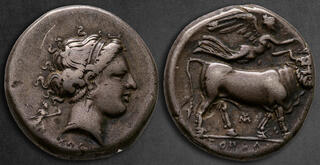| Savoca Numismatik GmbH & Co. KG > Online Auction 209 | Silver | Auction date: 28 April 2024 |
| Lot number: 6 Price realized: 460 EUR (Approx. 493 USD) Note: Prices do not include buyer's fees. | Show similar lots on CoinArchives Find similar lots in upcoming auctions on |
| Lot description: Campania. Neapolis circa 300 BC. Nomos AR 20 mm, 7,20 g Diademed head of nymph to right; to left, Artemis running right, holding torch; XAPI below / [NEΟΠΟΛITΩN], Man-headed bull walking right; above, Nike flying right, placing wreath on bull's head; MY monogram below. Very Fine, Toned HN Italy 579; SNG BN 786. Neapolis Campania, commonly referred to as Neapolis, was an ancient Greek city located in the region of Campania in southern Italy. The name Neapolis translates to "New City" in Greek, reflecting its foundation as a colony of Cumae in the 6th century BC. Neapolis was strategically situated on the coast of the Bay of Naples, near the base of Mount Vesuvius. Its location facilitated maritime trade and communication with other Greek colonies in Italy and the wider Mediterranean region. The city thrived as a commercial center, benefiting from its access to fertile agricultural land and its proximity to important trade routes. Throughout its history, Neapolis was influenced by various cultures, including Greek, Etruscan, and Roman. It was known for its vibrant cultural life, which included theater, art, and philosophy. The city also played a significant role in the spread of Greek culture and civilization to Italy and beyond. One of the most famous landmarks of Neapolis was its theater, which was one of the largest in the ancient world. Built during the 4th century BC and later expanded by the Romans, the theater could accommodate thousands of spectators and hosted dramatic performances, musical events, and civic gatherings. Neapolis was also renowned for its contributions to literature and philosophy. The city was the birthplace of several notable figures, including the philosopher and mathematician Philolaus, who was associated with the Pythagorean school of thought. During the Roman period, Neapolis continued to prosper as a center of trade and culture. It became a popular destination for wealthy Romans seeking leisure and entertainment, with luxurious villas and resorts lining the coast. Today, the modern city of Naples occupies the site of ancient Neapolis. Despite centuries of urban development and change, Naples still bears traces of its ancient past, including archaeological remains, historic landmarks, and a rich cultural heritage that reflects its Greek origins. Starting price: 50 EUR |  |


